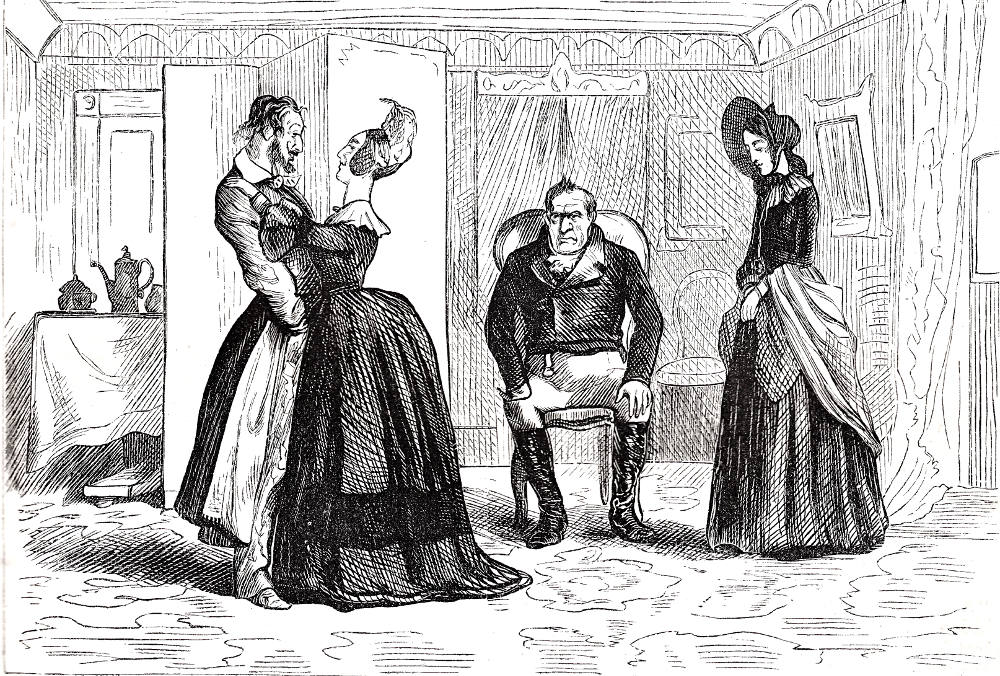
"He shall be horsewhipped till he cries out demnably." [Page 59] by Charles Stanley Reinhart (1875), in Charles Dickens's The Life and Adventures of Nicholas Nickleby, Harper & Bros. New York Household Edition, for Chapter X. 9.4 x 13.6 cm (3 ¾ by 5 ¼ inches), framed. Running head: "Preliminaries" (59). [Click on the images to enlarge them.]
Passage Illustrated: Ralph arranges for Kate's gainful employment
"I didn’t even know Mr. Nickleby was here, my love," said Madame Mantalini.
"Then what a doubly demd infernal rascal that footman must be, my soul," remonstrated Mr. Mantalini.
"My dear," said Madame, "that is entirely your fault."
"My fault, my heart’s joy?"
"Certainly," returned the lady; "what can you expect, dearest, if you will not correct the man?"
"Correct the man, my soul’s delight!"
"Yes; I am sure he wants speaking to, badly enough," said Madame, pouting.
"Then do not vex itself," said Mr. Mantalini; "he shall be horse-whipped till he cries out demnebly." With this promise Mr. Mantalini kissed Madame Mantalini, and, after that performance, Madame Mantalini pulled Mr. Mantalini playfully by the ear: which done, they descended to business.
"Now, ma’am," said Ralph, who had looked on, at all this, with such scorn as few men can express in looks, "this is my niece."
"Just so, Mr. Nickleby," replied Madame Mantalini, surveying Kate from head to foot, and back again. "Can you speak French, child?"
[Chapter X, "How Mr. Ralph Nickleby provided for his Niece and Sister-in-Law," 58-59]
Commentary: Kate's labouring future

Fred Barnard's British Household edition study of Kate's sadly making her way home through a busy London shopping street: Kate walked sadly back to their lodgings in the Strand (1875).
The Household Edition illustrations for the tenth chapter transport readers back to London from the Yorkshire scenes of the previous chapters. Reinhard in the Harper and Brothers volume focuses on the Mantalinis, who have agreed to Ralph Nickleby's proposition that his niece come to work for them as an apprentice milliner, decidedly a step down socially for a young man from an upper-middle-class family. Barnard in the Chapman and Hall volume directs readers to consider Kate's plight as she is now without her brother's protection and has seen the dilapidated Thames-side house in which her uncle intends to install her mother and herself.
Mrs. Nickleby's initial reaction to Ralph's vocational plans for Kate is dismay. However, she is mollified by Ralph's assurance that such a career could lead to the accumulation of considerable wealth for a young woman with a talent for design and needlecraft. While Ralph and his niece are walking towards Mrs. Matalini's establishment, she expresses her gratitude towards her uncle, and then, recalling her father's recent death and her brother's departure for Greta Bridge, she breaks down. However, Ralph reassures her that, although she will be working long hours, she will be able to continue to live with her mother, but of course no longer as Miss LaCreevy's respectable tenant.
No sooner have they arrived at their destination than Kate encounters a licentious, leering Italian — none other than the Mayfair dressmaker's womanizing husband, Signor Alfredo Mantalini, a lazy ne'er-do-well who lives off his wife's industriousness. His wife attempts to persuade Kate that her husband merely enjoys looking at attractive young women and talking to them, and that Kate should not construe his manners and language as disrespectful or lascivious (but Kate is not entirely convinced). And now for her dress-making position: Kate will be working twelve hours a day (9:00 A. M. to 9:00 P. M.), and may even have to put in paid overtime. The employer will provide both tea and dinner. Mrs. Mantalini's rates of pay (five to seven pounds annually) are about standard for the era: Kate will receive wages at the upper end of the scale if she proves herself adept and productive. She is to start on Monday. As she walks home, Kate despondently contemplates her much-changed circumstances as she and her mother must, Ralph has told her, move on Saturday to his run-down investment property on the river.
Related material by other illustrators (1838 through 1910)
- Nicholas Nickleby (homepage)
- Phiz's 38 monthly illustrations for the novel, April 1838-October 1839.
- Cover for monthly parts
- Charles Dickens by Daniel Maclise, engraved by Finden
- "Hush!" said Nicholas, laying his hand upon his shoulder. (Vol. 1, 1861)
- The Rehearsal (Vol. 2, 1861)
- "My son, sir, little Wackford. What do you think of him, sir?" (Vol. 3, 1861)
- Newman had caught up by the nozzle an old pair of bellows . . . (Vol. 4, 1861).
- Sol Eytinge, Jr.'s 18 Illustrations for the Diamond Edition (1867)
- Fred Barnard's 59 Illustrations for the British Household Edition (1875)
- Harry Furniss's 29 illustrations for Nicholas Nickleby in the Charles Dickens Library Edition (1910)
- Kyd's four Player's Cigarette Cards (1910).
Scanned image, colour correction, sizing, caption, and commentary by Philip V. Allingham. [You may use this image without prior permission for any scholarly or educational purpose, as long as you (1) credit the person who scanned the image, and (2) link your document to this URL in a web document or cite the Victorian Web in a print one.]
Bibliography
Barnard, J. "Fred" (il.). Charles Dickens's Nicholas Nickleby, with fifty-nine illustrations. The Works of Charles Dickens: The Household Edition. 22 vols. London: Chapman and Hall, 1875. Volume 15. Rpt. 1890.
Dickens, Charles. The Life and Adventures of Nicholas Nickleby. With fifty-two illustrations by C. S. Reinhart. The Household Edition. New York: Harper & Brothers, 1875.
__________. "Nicholas Nickleby." Scenes and Characters from the Works of Charles Dickens, being eight hundred and sixty-six drawings by Fred Barnard et al.. Household Edition. London: Chapman and Hall, 1908.
Created 10 April 2021